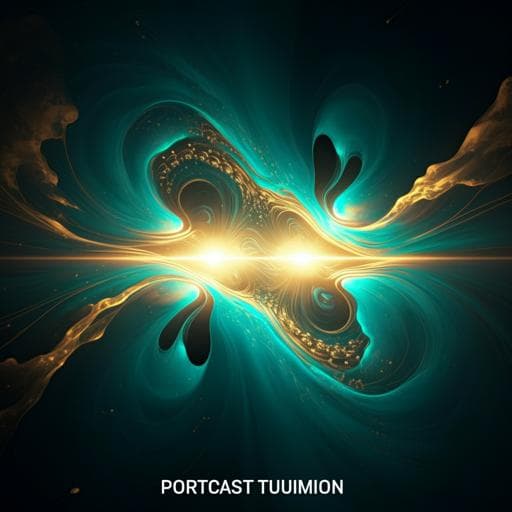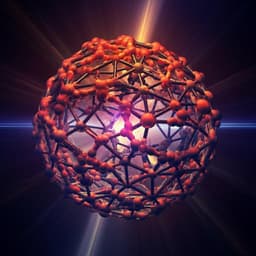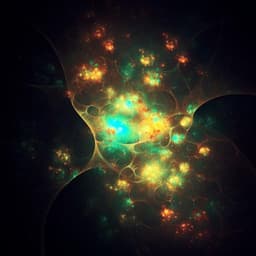
Physics
Rational design of large anomalous Nernst effect in Dirac semimetals
P. Wang, Z. Hu, et al.
This research conducted by Panshuo Wang, Zongxiang Hu, Xiaosong Wu, and Qihang Liu unveils a significant enhancement in anomalous Nernst conductivity (ANC) with Dirac nodes in a Zeeman field, surpassing traditional Weyl semimetals. With first-principles calculations indicating impressive ANC values, this work sets a new design principle for optimizing electronic structures.
~3 min • Beginner • English
Introduction
The study addresses how to rationally design materials with large anomalous Nernst conductivity (ANC) pinned near the intrinsic Fermi level. While anomalous Nernst effect (ANE) enables transverse thermoelectric energy conversion without external magnetic fields, most materials with sizable ANE have been identified serendipitously and often require tuning the chemical potential. The authors leverage the Mott relation linking ANC to the energy derivative of anomalous Hall conductivity (AHC) to posit that a band structure exhibiting opposite-sign AHC peaks on either side of the Fermi level, along with compensated carriers experiencing Berry curvature of the same sign, will maximize ANC at the Fermi level. They propose Dirac semimetals under a Zeeman field as a general electronic-structure platform to achieve this, offering a pathway beyond specific material families.
Literature Review
Prior efforts to realize large ANE have focused on topological semimetals hosting strong Berry curvature near Weyl points or nodal lines, yielding ANC on the order of ~0.1–10 Am−1K−1 in systems such as Co2MnGa, Co3Sn2S2, Mn3X (X = Sn, Ge), and various Heusler compounds. Despite these advances, reported ANC and transverse thermopower remain insufficient for applications, and optimal performance often requires carrier doping to shift the Fermi level. Theoretical understanding via the Mott relation indicates that maximizing ANC requires steep energy dependence of AHC near EF, motivating a search for electronic structures with double-peak, opposite-sign AHC around EF and carrier compensation.
Methodology
The work combines model Hamiltonians with first-principles calculations and Berry-curvature-based transport formalisms. 1) Model systems: (a) A tilted two-band Weyl model H = A(kxσx + kyσy) + M(k^2 − kw^2)σz + tkzσ0 describes a pair of Weyl nodes at (0,0,±kw) with tilt t, establishing a baseline where AHC is even in chemical potential and ANC vanishes at EF. (b) A four-band Dirac model formed by time-reversal pairs of the Weyl model is augmented by a Zeeman term S to break time-reversal symmetry: in concise form H = A(kxτxσx + kyτyσy) + M(k^2 − kw^2)τzσz + Sτ0σz (notation indicates two spin copies). The Zeeman field splits the Dirac nodes into two pairs of Weyl nodes forming a G-type chirality arrangement, yielding an odd-distributed, double-peak AHC and an even ANC maximized at EF. Parameter sweeps evaluate dependence of the maximum ANC at EF on Fermi velocity A, inverse effective mass M, node separation kw, and Zeeman strength S, at 100–300 K. 2) First-principles materials modeling: Density-functional theory (VASP, GGA-PBE, PAW) including spin-orbit coupling is used to compute band structures for Na3Bi and NaTeAu (both P63/mmc Dirac semimetals with Dirac nodes on Γ–A protected by C3 symmetry). Maximally localized Wannier functions (Wannier90) generate tight-binding Hamiltonians including relevant Na s, Bi/Te s,p, and Au s,d states. A Zeeman term is added: H = HTB + g μB B (B along z), with effective g-factor used to estimate requisite B for a target Zeeman splitting. Berry curvature and transport: AHC is computed via Kubo formula integrating Berry curvature over the Brillouin zone. ANC is obtained by replacing the Fermi-Dirac distribution with a Gaussian-like weight approximating its derivative; in the low-T limit this reduces to the Mott relation α ∝ (∂σ/∂E)|EF. 3) Material design beyond external fields: An intrinsic ferromagnetic variant NaFeTe2Au2 (50% Na → Fe) is proposed to provide internal exchange splitting (intrinsic Zeeman) without ordinary Nernst contribution; a full Heusler ferromagnet Co2PdGe is also examined for large ANC near EF.
Key Findings
- Model comparisons: • Two-band tilted Weyl model produces an AHC even in chemical potential with a single peak near EF (~220 Ω−1 cm−1) and an ANC that is odd, with symmetric maxima ~1.1 Am−1 K−1 away from EF and exactly zero at EF. • Four-band Dirac model with Zeeman splitting yields four Weyl nodes forming a G-type chirality configuration; AHC is odd-distributed with two opposite-sign peaks (reported magnitude ~2190 in figure units) straddling EF, and ANC is an even function exhibiting a maximum at EF of ~3.2 Am−1 K−1 (~300% enhancement relative to the Weyl model). Additional smaller symmetric ANC peaks (~1.3 Am−1 K−1) appear on both sides of EF. - Parameter dependencies (at 300 K unless noted): • ANC maximum vs Fermi velocity A: increases then decreases with an optimum around A ≈ 0.16 eV·Å. • vs inverse effective mass M: increases and tends to saturate as M increases (lighter effective mass). • vs node separation kw: increases monotonically with kw. • vs Zeeman strength S: increases then decreases due to competing effects (stronger TRS breaking vs wider AHC peak separation reducing slope), with an optimum near S ≈ 60 meV. Trends at 200 K are similar; at 100 K the ANC is smaller due to temperature broadening considerations. - Na3Bi under Zeeman field (23 meV, B ≈ 20 T for g ≈ 20): • Band splitting along Γ–A is asymmetric (the branch with lower Fermi velocity splits more), preventing the desired double-peak AHC. • AHC σxy shows a single maximum peak ~37 Ω−1 cm−1 near EF. • ANC αxy shows two opposite peaks ~0.38 Am−1 K−1 near EF; αyz and αzx are negligible for field along z. - NaTeAu under Zeeman field (29 meV, B ≈ 25 T for g ≈ 20): • Symmetric splitting of the Dirac branches along Γ–A produces a G-type arrangement of two Weyl pairs. • AHC σxy exhibits two opposite-sign peaks at E ≈ 0.01 eV and 0.13 eV with maximum magnitude ~81 Ω−1 cm−1, yielding a steep slope near EF. • ANC αxy reaches ~1.3 Am−1 K−1 at E ≈ 0.07 eV; αyz and αzx are near zero for B ∥ z. - Intrinsic ferromagnets: • NaFeTe2Au2 (intrinsic FM via 50% Na→Fe): AHC vs chemical potential shows a double-peak feature; ANC peaks at EF at ~3.7 Am−1 K−1. • Co2PdGe (full Heusler, designed): exhibits large ANC ~6.2 Am−1 K−1 near EF (at ~0.16 eV). - Conceptual advance: Dirac semimetals with Zeeman splitting enable compensated electron and hole carriers experiencing same-sign Berry curvature, creating an odd, double-peak AHC and pinning a large ANC at EF, consistent with the Mott relation.
Discussion
The results demonstrate a general electronic-structure strategy to achieve large ANE pinned at the Fermi level: start from a Dirac semimetal and introduce Zeeman splitting to generate two pairs of Weyl nodes arranged such that the AHC is odd with double peaks straddling EF. This configuration maximizes the energy derivative of AHC at EF, thereby maximizing ANC there per the Mott relation. Carrier compensation, with both electron and hole pockets subject to same-sign Berry curvature, further enhances the transverse thermoelectric response without cancellation as in longitudinal Seebeck effects. The approach applies both with external magnetic fields acting as Zeeman fields (distinct from ordinary Nernst effects driven by Lorentz force) and with intrinsic exchange fields from ferromagnetism. Parameter tuning (e.g., via strain, composition, magnetic proximity) offers practical levers to optimize Fermi velocity, effective mass, node separation, and Zeeman strength. The findings on Na3Bi and NaTeAu exemplify how band-splitting symmetry affects whether the ideal double-peak AHC emerges, and the designed NaFeTe2Au2 shows that intrinsic magnetism can realize the targeted ANC pinning at EF. Given the broad temperature range over which ANE remains finite, the ANE can be comparable to ordinary Nernst at higher temperatures.
Conclusion
The study provides a design guideline for maximizing anomalous Nernst conductivity at the Fermi level by engineering Dirac semimetals under Zeeman fields to realize an odd, double-peak AHC and compensated carriers with same-sign Berry curvature. A four-band Dirac model with Zeeman splitting achieves ~300% higher ANC at EF compared to a two-band Weyl model. First-principles calculations predict sizable ANC near EF in Na3Bi (~0.38 Am−1 K−1) and NaTeAu (~1.3 Am−1 K−1) under Zeeman splitting, and higher values in intrinsically ferromagnetic NaFeTe2Au2 (~3.7 Am−1 K−1) and Co2PdGe (~6.2 Am−1 K−1). This prototype band-structure framework enables inverse design of ANE materials. Future work may explore broader materials spaces (e.g., additional Dirac/Weyl systems, Heuslers, van der Waals magnets), optimize intrinsic exchange splitting without large external fields, and employ strain or chemical substitution to tune the key parameters (A, M, kw, S) for EF-pinned ANC enhancement.
Limitations
- Realization of the optimal ANC enhancement depends on achieving appropriate Zeeman splitting; in the external-field scenario, estimated fields (∼20–25 T for g ≈ 20) are large. - The desired symmetric splitting of Dirac branches (yielding a clear double-peak AHC) may not occur in all Dirac semimetals (e.g., Na3Bi shows asymmetric splitting and consequently a single AHC peak). - Predictions are based on DFT (GGA-PBE) and Wannier-interpolated Berry curvature; quantitative values may vary with exchange-correlation functionals or many-body effects. - Some proposed materials (e.g., NaFeTe2Au2, Co2PdGe) are designed/hypothetical and require experimental synthesis and validation. - Temperature broadening affects ANC magnitude and the precise energy of maxima, implying sensitivity to operating temperature.
Related Publications
Explore these studies to deepen your understanding of the subject.







